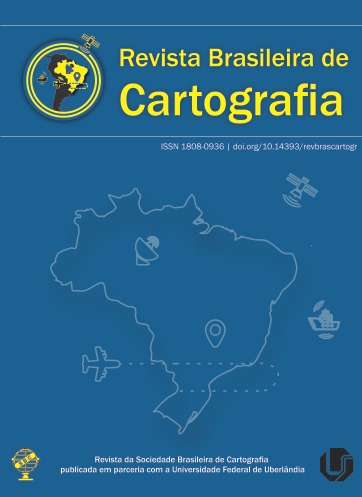A Influência das Edificações no Cálculo do Efeito Gravitacional das Massas Topográficas – Estudo de Caso na Cidade de Porto Alegre – RS (Brasil)
Conteúdo do artigo principal
Resumo
Um dos objetivos da Geodésia consiste no estudo do geoide e sua determinação é obtida através do conhecimento do campo de gravidade que envolve a distribuição de massas na superfície terrestre. A abordagem clássica para a solução do problema de valor de contorno da Geodésia (PVCG) visando a determinação do geoide assume que os efeitos associados à topografia sejam levados em consideração. A técnica de Modelagem da Topografia Residual (RTM, em inglês Residual Terrain Modelling) tem como objetivo a modelagem o campo de gravidade em função da distribuição de massas associada a topografia onde, nesse tipo de estudo, o conteúdo de alta frequência do espectro relacionado a gravidade é gerado através desse método de redução associado a um modelo digital de elevação (MDE) de alta resolução. Nesse contexto, o objetivo principal desta pesquisa consiste em calcular o valor do potencial gravitacional das massas topográficas oriundas de edificações existentes na cidade de Porto Alegre – RS juntamente com a anomalia de gravidade associada à topografia. Esse estudo foi desenvolvido a partir de uma base vetorial com mais de 200 mil edificações onde o potencial gravitacional foi calculado a partir de um MDE gerado através de dados LiDAR (light detection and ranging). Para auxiliar nos cálculos, foi estimado um modelo de densidades em função das dimensões de cada edificação existentes na base de dados. Assim, foram calculados o valor do potencial gravitacional utilizando os elementos de massa tesseroide, prisma e massa pontual e também o valor da anomalia de gravidade para distâncias de 1 km, 2 km, 5 km, 10 km e 20 km usando a técnica de modelagem RTM. A influência das massas das edificações, neste estudo, representou 10,62% do valor da anomalia de gravidade em comparação com o seu correspondente em relação ao solo.
Downloads
Detalhes do artigo
Seção
Autores que publicam nesta revista concordam com os seguintes termos:
- Autores mantém os direitos autorais e concedem à revista o direito de primeira publicação, com o trabalho simultaneamente licenciado sob a Licença Creative Commons Atribuição que permite o compartilhamento do trabalho com reconhecimento da autoria e publicação inicial nesta revista.
- Autores têm autorização para assumir contratos adicionais separadamente, para distribuição não-exclusiva da versão do trabalho publicada nesta revista (ex.: publicar em repositório institucional ou como capítulo de livro), com reconhecimento de autoria e publicação inicial nesta revista.
- Autores têm permissão e são estimulados a publicar e distribuir seu trabalho online (ex.: em repositórios institucionais ou na sua página pessoal) a qualquer ponto antes ou durante o processo editorial, já que isso pode gerar alterações produtivas, bem como aumentar o impacto e a citação do trabalho publicado (veja "O Efeito do Acesso Aberto").





